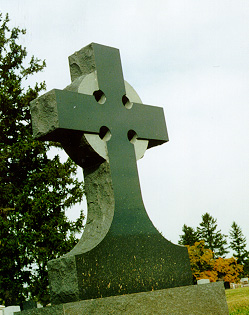|

This granite Celtic cross is similar to the one
planned for the Irish workers grave site.
By Michael G. Matejka
Railroad work has always been hard and difficult, physical labor
that takes its toll whether done in the blazing sun, winter snows or
deepest night. Workers today, however, enjoy improved conditions
thanks to union contracts. In central Illinois remains a stark
reminder of how difficult a railroader's life once was.
Nestled among the falling leaves at Funk's Grove cemetery, 12 miles
south of Bloomington, Illinois are two strips of unmarked graves, 10
feet wide by almost 40 feet long. There lie approximately 50 Irish
workers, victims of difficult railroad construction conditions 150
years ago.
A central Illinois effort is mobilizing to mark those graves, a
memory to the hard conditions immigrant workers faced.
In 1853 Bloomington, Illinois was bustling with anticipation, the
coming railroads meaning economic opportunity for the small outpost.
That spring the Illinois Central Railroad, building south from
Freeport, Illinois reached Bloomington. And in October the Alton and
Sangamon Railroad, building northward from Springfield, Illinois
reached Bloomington.
Today the Illinois Central's roadbed is a bike trail. The Alton and
Sangamon is the Union Pacific Railroad, running from Chicago to St.
Louis, used by Amtrak and regular freight trains.
Forgotten are the dismal conditions and hard physical labor that
built railroads and canals before the Civil War. Hungry and
impoverished Irish laborers were the preferred workforce. The grunt
work of digging, shoveling, grading, track-laying and building fell to
them.
The potato famine in Ireland, beginning in 1847, devastated the
Irish countryside. Unable to support themselves on their tiny plots,
peasants fled to ocean ports. Some immigrated to English cities,
finding jobs in the new factories. Others took ships, popularly known
as "coffin ships," for hazardous voyages to the New World.
Many of these vessels were former slave trade ships. With poor water,
sanitation and food aboard, many voyages reached the U.S. with only
half of their passengers.
Once in America these immigrants sought work and were welcomed by
expanding railroads. These construction projects were built almost
entirely by pick, shovel and spade, with occasional use of dynamite or
horse power.
Sanitary conditions and health care were minimal in the isolated
construction camps. Infectious diseases like cholera and dysentery
could spread quickly, killing numerous workers. Many of these workers
were already weakened by famine and poor nutrition, likely candidates
for infection and disease. The Illinois Central Railroad, building
from 1851 - 1857, lists over 100,00 workers in its record books,
though it only employed 10,000 at any one time. Not all of these
workers died, some settled in communities along the lines, but the
tales of accidents and disease are numerous.
The specific circumstances of these deaths are lost to history. The
Funk's Grove cemetery's sparse records simply say "Irish
Workers." The oral tradition in the area is that they died
building the railroad. The Funk and Stubblefield families had settled
the area in the 1820s and established their cemetery. What is unique
is that these workers, although their graves were not marked, were
buried in a cemetery, instead of simply placed in a shallow grave
along the railroad right-of-way. The number of workers are not clear,
though 50 is the tradition. Two long strips of land, marking a mass
burial, are in the cemetery's plots.
Currently a community committee is attempting to raise $12,500. The
aim is to build a two-foot tall base at the cemetery, and on that
erect a four-foot Celtic cross. A plaque will honor those forgotten
workers. If the money is raised, the cross's dedication is planned for
Workers Memorial Day, April 28, 2000. A historical booklet is also
planned.
All donors are invited to submit names of forebears they would like
remembered in the memorial booklet.
Donations are tax deductible and can be sent to the McLean County
Historical Society/Irish Memorial Fund, 200 N. Main Street,
Bloomington, Illinois, 61701. For more information, contact Mike
Matejka at the Union News, 309-827-3934.
Planned Plaque inscription:
This Celtic cross honors the memory of more than
50 souls buried here about 1853.
Their names are known but to God. These
immigrants from Ireland were driven
from their home by famine. They lie buried here
in anonymity, far from the old
homes of the heart, but forever short of the new homes
of their hopes.
They arrived sick and penniless, and took hard
and dangerous jobs
building the Chicago & Alton Railroad. Their
sacrifices made it
possible to develop the riches of the land we
enjoy today.
|

